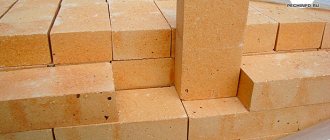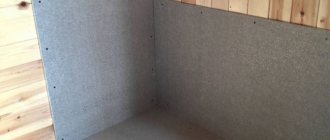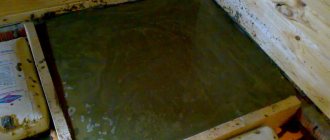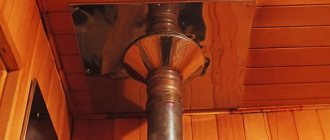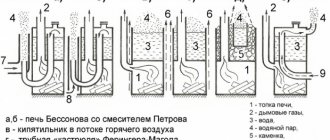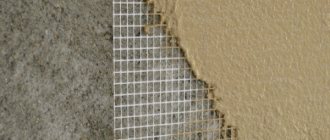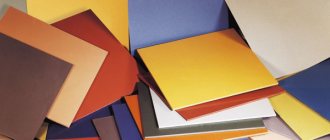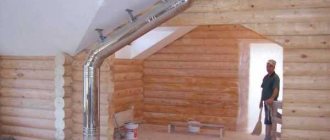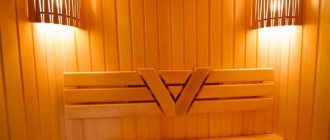An integral part of any bathhouse is the stove, which heats the bathhouse and makes the steam room comfortable and cozy. Most often, stoves are made of some kind of metal.
A metal stove is the fastest to install, it heats up quickly, has an affordable price and suitable dimensions.
But metal retains heat for only a short time and cools quickly, so you often have to add firewood. To correct this and improve the room, special sauna stoves are made to be lined with brick.
Features of installing iron stoves
Installation in a steam iron stove is a common solution. Unlike other options, it has many advantages:
- simple and quick installation;
- the manufacturing technology of metal furnaces is carried out in a semi-automatic mode, with almost no human intervention required, this reduces the cost of finished products;
- the metal has good thermal conductivity, so energy is not wasted, but is spent exclusively on heating the furnace;
- compact dimensions are especially important for small steam rooms, when every meter is taken into account;
- products with an upper blower on one load of fuel can operate for up to 12 hours, which makes them quite economical.
In some cases, it makes sense to cover not only the stove with brick, but also one of the walls; this will favorably emphasize the interior of the steam room. Source strbani.ru
Despite the fact that today iron stoves have a representative and attractive appearance, they look great in the interior of the room against the background of laminated veneer lumber or a log house not entirely organic. And this is not the main reason to line the stove with bricks; there are other reasons:
- if you overdo it with fuel, the heat from the stove will become so intense that it will first begin to smolder, and then the finishing of the steam room may catch fire;
- the surface of the iron becomes so hot that you can get burned on it, plus this contributes to overheating of the steam room;
- the metal warms up quickly, but also cools quickly, so it is difficult to control the temperature;
- you can get burned when touching metal, and in the case of masonry this possibility is eliminated, since it absorbs heat and distributes it over the entire surface;
- brick against a wood background looks much better than iron, which gives an organic feel to the interior;
In some cases, the stove is not completely covered with brick, it depends on the preferences of its owner Source termopaneli59.ru
- iron stoves have few modifications, almost all models of these bathhouse elements are similar to each other, so lining with brick in this case allows you to create any shape;
- Over time, the metal loses its protective coating, and the stove becomes covered with rust, this spoils its appearance and also leads to thinning of the walls.
The disadvantages of iron products are not critical, but they do not allow you to relax comfortably in the steam room with health benefits. This situation can be corrected by laying bricks around the sauna stove.
Post-operation report
The necessary heating of the premises is achieved, there is no doubt about it. The fire begins on Friday at 21:00. You must first warm up the chimney and firebox. Then dry firewood is laid in - in two hours the room is completely heated. Be sure to open the air supply valve from the basement and the hot air outlet door so that there is continuous circulation. In the morning the temperature in the room is +20-22. Work on the construction of the furnace took 3 months (May, June, July). As a result, the total cost of the furnace amounted to 80 thousand rubles. Concluding the story, it should be noted that prices in the field of construction of stoves, fireplaces and chimneys are very high.
A promising option for heating a home using a heat-intensive fireplace - Ferlux-701.
Types of bricks
To choose the right material, you need to take into account certain nuances. An iron stove heats up significantly during operation, so it is recommended to choose one of the following types of bricks:
- Refractory. This material is the most optimal in terms of operation, however, it is also the most expensive. This is the most preferred type of brick.
Refractory brick is best suited for cladding, but it is expensive Source selmo.com.ua
- Silicate. It is not recommended to use an iron stove for cladding, since the components included in the composition react poorly to elevated temperatures. Therefore, already laid brick needs additional finishing.
Sand-lime brick is not often used for finishing, but it is the most budget option Source ytimg.com
- Red . Due to its high heat resistance and excellent thermal performance, this brick is often chosen for organizing a screen. Solid products are considered the best option, while hollow bricks are not recommended because they both heat up quickly and cool down quickly. This material has an attractive appearance and, when installed correctly, can decorate the interior of a bath room.
Attention! If wooden elements are located near the brickwork, they must be treated with protective compounds to prevent the surfaces from spontaneous combustion.
Red brick will be an ideal solution for finishing a stove Source t-spectr.ru
See also: Catalog of companies that specialize in the design and installation of fireplaces and stoves
We buy a firebox
A budget version of the firebox was chosen. Subsequent operation showed that secondary afterburning works perfectly, the lower damper and gate actually regulate combustion within the required limits. The “clean glass” system helps to leave glass behind during intense burning of dry hardwood firewood. When burning damp, resinous wood, as well as when laying a whole log and switching to a long burning mode, the glass smokes, but not much. In the morning, the cooled glass is simply wiped with a damp cloth. Operating practice shows that it is impossible to lift the glass to observe an open flame. Regular dry firewood is used for kindling.
Sheathing options
The brick lining of the furnace is used to organize a heat shield. This means that it bears the main thermal loads. The following cladding options are available:
- a convector with vents is ideal for a steam room, since, regardless of the area of the room, it improves the performance of any iron stove;
- the heat screen is a stone fence that allows you to provide comfort to people near the stove;
- a continuous lining creates rapid heat transfer, this reduces the efficiency of the furnace, so this option is rarely used, it plays more of a decorative role, but does not greatly affect the performance.
Attention! The design of its lining will significantly depend on the main purpose of the stove. If facing the stove in a bathhouse with brick plays a decorative role, then you can lay the screen in a whole brick. If you need to organize a water heater, lay it in half a brick.
When lining a stove with brick, be sure to leave holes at the bottom and top of the masonry, this will allow air to circulate normally Source pechnoy.guru
Design, calculation and purchase of materials
The firebox has been purchased - you can start the project. The power of the device is 13 kW, which is already 2 times higher than the calculated one. The calculation was made using a special calculator, having the size, power, dimensions of the device available, and numerous photographs and videos were previously viewed on the Internet. It was calculated that 225 bricks were needed for the front part of the furnace. Shaped kiln bricks from the Engels plant were chosen for construction. The bricks were purchased with a reserve, and also in a convenient format - piece by piece at an affordable price. Cleaning doors were also purchased there, which were needed to close the hot air outlets from the furnace and a damper for the air duct from the basement for good air ventilation.
It was decided to lay out the sides of the stove facing the adjacent rooms, namely the kitchen and bedroom, with solid red brick, which was available. This can be done, since the parts will not come into contact with the fire. To prepare the solution, you can use ready-made masonry stove mixture, which was purchased in 20 bags. You also need a couple of bags of cement to fill the base for the stove and chimney in this design: up to the attic - a sleeve (heat-resistant stainless steel 321), lined with bricks, then through the attic and onto the roof a sandwich will go. I prepared a set of necessary tools, quite natural for such work. A grinder and a laser level are also necessary.
Sheathing stages
Before you line an iron stove with bricks in a bathhouse, you need to prepare. To carry out the work, the master will need M150 solid brick, clay, sand, concrete, crushed stone. To create the formwork you will need boards, waterproofing and rods for reinforcement. The tools you need to prepare are a level, a shovel, a tape measure, a pencil, a trowel, and a plumb line.
Attention! If the stove came complete with a convection casing, it must be removed, since its role is now played by the lining.
Today there are many types of iron stoves, the lining of each of them has certain nuances Source wp.com
Foundation construction
The strength of the stove structure and how long it will last will depend on the foundation, therefore, it is better to choose which stove in the bathhouse at the design stage. If the total weight of the stove with laid masonry is no more than 750 kg, a separate foundation will not be required for it. Otherwise, you will need to carry out a number of works to arrange a reliable foundation. In general, they do not differ from the work on arranging any other foundation:
- If the foundation is strip, then a pit is dug for it, in which the formwork is installed and waterproofed.
Heavy metal stoves will require a reinforced foundation Source banya-expert.com
- When the formwork is ready, a 20 cm layer of crushed stone and sand is poured over it, then it is watered and compacted.
- Reinforcement is laid and a mixture of concrete, sand and crushed stone is poured (in a ratio of 1: 4: 3). Everything is leveled up; if necessary, flaws are corrected.
- After the poured foundation is left to harden for approximately 14-20 days.
When the concrete has completely dried, the base is laid: waterproofing is made from roofing felt, and metal sheets 1-2 mm thick are laid on top of it, on which there will be an iron stove.
Chimney pipe installation
The chimney will be made of two parts. The lower part from the firebox through the first and second floors to the exit to the attic is a stainless steel sleeve. The steel was assembled “by smoke” and was firmly lined with brick. The upper part was made through a cold attic with access to the roof and a height according to SNiP of at least 0.5 m. Above the ridge is a stainless steel sandwich assembled over condensate. The structure is very heavy; the chimney was moved outside the stove and, as a result, has a separate base for the brickwork and does not come into contact with it in any way.
The chimney liner and sandwich were assembled independently after the firebox was in place and about half of the stove was laid out. The brickwork had to be done after the stove was laid. To attach the sleeve, stainless steel brackets were used, which were purchased along with the pipe. The chimney was installed autonomously, for which there were reasons:
- Nothing stopped him from making temperature fluctuations.
- Vibrations of other structures, such as interfloor ceilings, partitions, roofs and others did not affect it.
- Nobody excludes fire safety requirements and SNiP.
We did not encounter any difficulties during installation. Installing the chimney took half a day. A neighbor helped with difficult work, especially on the roof.
Video description
How to properly make clay mortar for laying bricks for lining a sauna stove, watch the video:
Brick preparation
First, the brick for lining the stove in the bathhouse must be prepared. To do this, it needs to be soaked in water for 10 hours before installation.
Before starting work, you need to do the following with bricks:
- determine compliance with the overall dimensions, the surface must be free of cracks and other mechanical deformations, the rejected material will be used in the future to fill voids at the end of the rows;
- the brick is taken out of the water 30 minutes before laying, so the surface has time to dry, and while laying the rows it will not absorb water from the mixed mortar, without thereby reducing its viscosity.
Correctly selected and prepared brick will greatly facilitate the work of lining the furnace Source ytimg.com
Bricklaying
You can cover the stove in a bathhouse with bricks in one of two ways - a solid well and a lattice one.
The latter method looks more beautiful because it involves the presence of a large number of holes. But it is precisely this specific design that reduces the effect of the heat shield.
Attention! If the stove is round in design, then the masonry is made taking into account its contour.
The brick should retreat approximately 50 mm from the stove body. No spacers need to be installed. Iron expands when heated, which will create pressure on the brick wall.
On an average stove you will need to lay approximately 12-16 rows. It is advisable to carry out the laying in stages. You can lay out 6-8 rows per day, leaving them overnight. In the morning they check how much the structure has sagged, then they begin laying the remaining rows.
Preparation of mortar for masonry
One of the important elements of masonry is the mortar.
To make the structure durable, heat-resistant and reliable, certain components are used for the solution; there are 3 main options:
- cement mixture, which is mixed with fireclay clay;
- sand-clay solution of sufficient plasticity so that cracks do not appear on it when heated;
- cement-adhesive mortar, to which a special adhesive composition for ceramic granite is added.
Video description
Watch the video for the most common mistakes when lining a metal stove in a bathhouse:
Attention! Some craftsmen suggest covering the stove in the bathhouse with bricks up to the stove on which the coals are located. This is an interesting solution, it allows you to admire the hot stones. Others, on the contrary, completely cover the chimney with brick rows. Therefore, you need to choose masonry taking into account personal preferences.
If the chimney has a presentable appearance, it does not need to be covered with bricks Source legkovmeste.ru
Step-by-step instruction
Forming the base
In order for a brick-lined sauna stove to be strong and reliable, it is important to lay the foundation correctly. The strip foundation is considered the easiest to assemble and install. To equip it, the wooden floor elements in the house are first dismantled, after which a trench is dug, the bottom of which is covered with a sand-crushed stone mixture.
Everything is compacted well and watered. The next stage is concreting the foundation. For the strength and reliability of the structure, it is recommended to additionally lay a reinforcing mesh into the foundation before pouring it. The solution is then left to dry. Until the base is completely dry, further work is not recommended.
Briefly about the commander in chief
Experienced craftsmen say that the lining of the stove in the bath should be half a brick. This is the most suitable option. You can install a damper in a whole brick, but this structure will take much longer to warm up, and the foundation for this wall will require a more massive one.
The entire technological process consists of the following stages:
- preparation of materials;
- choice of location;
- foundation organization;
- laying the base;
- choice of brick and laying method;
- preparing bricks for cladding;
- furnace lining;
- first firebox;
- decorative finishing (if required).
Brick cladding of a sauna stove is needed not only for beauty. This event can significantly improve the atmosphere in the steam room. Moreover, the work is carried out with low material costs and with high quality, if you correctly follow the masonry technology and entrust it to specialists.
Ratings 0
How to do it?
If the stove itself is fenced off, then during the construction of the structure an opening is made for the firebox. To connect the main walls of the bathhouse with the partition, pieces of reinforcement are mounted at one end into the wall and at the other into the masonry joints. The diameter of the rod should be 6 mm. If a brick partition in a bathhouse is placed near the stove, then it would be correct to leave a window for the combustion channel. The progress of masonry work is carried out in the following order:
- The first thick layer of mortar is laid, leveled with a trowel, and creates the base of the wall. We need to give it time to catch on.
- Then another layer - thinner - under the first row of bricks. The mortar is applied to the ends of the outer bricks with a trowel, pressed tightly against the wall and excess mortar is removed. Using a stretched string, the evenness of the rows is controlled. And the level shows horizontal and vertical.
- The laying of the second and each even row begins with halves of material. This - dressing - is done to evenly distribute the load.
- Every 3-5 rows, pieces of reinforcement or steel wire are placed on the cement to provide strength.
- In a similar way, the entire wall is driven completely up to the ceiling. The remaining gap is filled with small pieces and fragments soaked in solution. Small cracks are sealed with tow.
- If the bulkhead is planned with a door, then the frame is set up in advance. It is attached to the brickwork using steel strips. The bricks are laid close to it. Do not forget to control the horizontalness and evenness of the masonry by moving the stretched string higher.
- After the solution has hardened, the seams are sanded.
